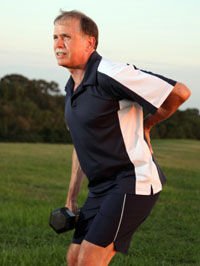
By Dr. Nicholas A. DiNubile, M.D.
Sports-medicine doctors know that psychological issues are important in dealing with orthopedic problems and injuries. And yet history has shown that many, if not most, of us aren’t very good at doing anything about them. There are times when I walk into an examination room, and before I even know what the patient’s issue is, I have a feeling—a sixth sense—that I won’t be able to help that person. I know that the right diagnosis and treatment won’t be enough to get that person better because there are emotional or other psychosocial issues involved. That “baggage” hasn’t been checked.
Orthopedic specialists are aware of the importance of a patient’s mind-frame. We’ve seen the same studies every other doctor has that unequivocally connect stress with immune dysfunction and disease, but we haven’t connected all the dots on how to help patients who are stressed out. Mind and body are seen as two completely different and completely separate realms. We, as surgeons, all too often just deal with the physical; we don’t get patients to the right person, or incorporate a team approach, or, perhaps most important of all, call on them to help themselves emotionally. The result is suboptimal healing and/or recovery and recurrent frame-related (or other) ailments.
That’s beginning to change in a big way. Psychoneuroimmunology (PNI) is a medical discipline, still in its formative stages, that was established to clarify the complex hormonal and biochemical triggers that alter the immune response and other physiological systems. Either these triggers allow your mind and central nervous system to give you a boost, or they set off a downward spiral.
The mind affects how you feel and how you heal.
Low-back pain—or any kind of physical pain, for that matter—can either be exacerbated or alleviated by our mental and emotional responses to it. Undoubtedly, you have witnessed this connection in some of your clients, or perhaps you have even experienced it yourself. After all, fitness professionals are not immune to physical or emotional pain. The following article examines that all-important mind-body connection, specifically as it relates to low-back pain, and offers useful strategies you can use with your clients—or for yourself—to relieve the stress and anxiety that makes the pain worse.
Stress and Low-back Pain

The connection between mind and body related to lower-back ailments is remarkable. It’s been documented beyond question that stress plays a major role in both acute and chronic pain. Researchers at Stanford University found that patients with poor coping skills were four times more likely to develop significant problems with their lower backs. In fact, psychological test scores were far more predictive of back problems than any structural abnormalities found on an MRI or other imaging! Other studies have shown that the best predictors of long-term, work-related lower-back disability have more to do with psychosocial factors like job performance and job satisfaction than any physical parameter.
Helen Flanders Dunbar, M.D., (1902–1952), an important early figure in U.S. psychosomatic medicine and psychobiology, said, “It’s not a question of whether an illness is physical or emotional, but how much of each.” Simply stated, if we ignore the emotional side, we’re not going to be as successful as we could be in helping clients get better.
In my experience, a significant number of doctors fail to appreciate this. So we see more tests, more surgeries, more utilization of our already strained health system—not always to the advantage of the patient. This is especially true in spine care. Stress, anxiety, depression and other emotional issues are often the elephant in the corner of the room that all are ignoring. But bringing up this issue and talking honestly about it may be one of the keys to you or your client getting better and/or avoiding unnecessary treatment.
“In Chinese medicine a symptom isn’t something to eradicate, but a message about where we need more balance.” —Dr. Frank Lipman
When it comes to psychological distress, clearly there is a wide range of severity. Anyone who is affected daily (work or relationship slippage) by any mind issue must seek professional help. If there are psychosocial issues in play, an individual should always talk to his or her doctor about possible interventions. I’ve heard, and I believe, that broken bodies are easier to heal than broken minds. Opening up and talking about these things is an important first step toward optimal healing and recovery.
Starve Whatever it Is That’s Eating You
Doctors aren’t the only ones not doing enough when it comes to mind-frame—everyone bears some responsibility for how they feel and how that affects their health. We may not always be able to do much about the circumstances that weigh upon us, but each of us can acknowledge these problems exist and take the necessary steps to combat them.
Relaxation Breathing
Unconsciously, most of us take shallow breaths all day long, and that is the rule whenever we are in an excited or agitated state that actually produces or exacerbates stress. The following routine is so simple that you or your clients can do it anywhere, and it’s something that should be done a few times every day whether you’re experiencing tension or not. Do not force any movements and remember to use slow, controlled movements.
1. Straighten your spine and keep your eyes closed during all of the steps in this breathing routine. Rotate your neck slowly to the right and hold for five seconds; repeat to the left. Bend your chin forward toward your chest and hold for five seconds; bend your head back as far as it will go comfortably and hold for five seconds. Bend your head toward your right shoulder as far as you can go and hold for five seconds; repeat to the left (again, within your comfort range).
2. Notice your regular breathing—feel it expanding your lungs, then emptying from your lungs.

3. Take deeper breaths and notice how the infusion of additional oxygen clears your head. Focus exclusively on this, driving everything else from your mind.
4. Take even deeper breaths slowly through your nose. Hold for one to two seconds. Release the air through your mouth while relaxing your entire body. Repeat three times.
5. Breathe normally through your nose three times, focusing on the oxygen coming into your body and thinking about it expanding your chest, entering your bloodstream and circulating from your forehead to your toes.
6. Continue taking slow, deep breaths through your nose, but now let your belly expand so that you’re breathing with your diaphragm. When your lungs are full, hold the breath for two seconds.
7. Release the breath slowly through your mouth and exhale until your lungs feel completely empty—contract your belly to force out every last air molecule. Wait two seconds.
8. Repeat the cycle three times, starting with step 4 above.
Once you or your clients get comfortable with this stress-busting routine (think “mental push-ups”), it can be done anytime, anywhere. Encourage your clients to try it lying down on their backs, or in bed at night with a pillow under their knees. Skip the neck exercises and just concentrate on the breathing. This type of mindful breathing can also be used to relax all of the muscles and even get added relief for the spinal area, a place where tension loves to hide.
ID Your Stress Buttons
There are certain things (or people)—at home, at work, at school, even at play—that set the mind and body racing. You usually know what they are (if not, you need to start figuring it out), and you know when they kick in. What you might not know is that you can train yourself to switch off your brain as soon as one of these things occurs. You can make the conscious decision to distract your mind with a more pleasant or innocuous thought. Practice this and then teach the technique to your clients—it works.
Open Your Relief Valve
You also know what calms you down, what distracts you from whatever worries you have and gets you into the psychological state called “flow.” Exercise, writing and juggling work for me; whatever works for you or your clients—a leisurely stroll, model building, poker playing, listening to your playlist, frolicking with the kids—should be brought into play whenever the need to let off steam arises.
Talk It Off
Keeping things bottled up can and will backfire with physical and emotional consequences. Talk to a friend, a significant other or your doctor. Let things out; it helps. One study showed that participation in an e-mail discussion group was enough to help reduce pain and disability in individuals with chronic lower-back pain.
Soothe Yourself

Progressive Muscle Relaxation (PMR)
In succession:
- Clench and unclench your jaw.
- Shrug your shoulders.
- Make a tight fist and release it.
- Tense and untense your arms, torso, pelvic area and legs.
- Feel the tension leave your muscles and body.
There is a host of things that pacify just like Mom used to do (or still does, if you’re fortunate to still have her with you). Listening to waves at the seashore or staring into a fire (and other repetitive nature sounds and images); taking a long, hot bath; massage; yoga; meditation; tai chi; progressive muscle relaxation (PMR—see sidebar); and hot tea or water with lemon all have remarkable salutary effects. Studies have shown that certain comfort foods can actually dampen or reduce pain signals—but be careful not to overeat! Take every opportunity you can to nurture your mind-frame.
Think Positive
It might not be in your nature to be optimistic, but its proven benefits are so huge that it pays to learn to suspend your disbelief or cynicism. Pick up a bestseller on this topic and adopt the approaches that are comfortable for you; if appropriate, recommend the book to your clients.
Guided imagery (used for centuries by yogis to control heart rate and body temperature) is a form of positive thinking. Studies have shown that an aquarium in a room can lower blood pressure and that conjuring a tranquil place or activity in your mind can have the same effect. Stay with the image, make it real and don’t be surprised if your tension eases.
Along with the previously mentioned approaches, don’t forget the basics:
- Eat right.
- Hydrate, hydrate, hydrate.
- Stick to an exercise program and get proper sleep.
There are a lot of proven stress reducers to choose from, but don’t let that increase your anxiety. The only “must learn” strategy is the relaxation breathing exercise because its calming effect not only cuts tension, but prepares your frame for exercise—lower back or otherwise. As for the rest, choose wisely and incorporate everything that’s appropriate to your circumstance and preference.
______________________________________________________________________

Nicholas A. DiNubile, M.D., is an orthopedic surgeon specializing in sports medicine, a best-selling author, and ACE’s chief medical advisor. He has served as orthopedic consultant to the Philadelphia 76ers and the Pennsylvania Ballet, and his award-winning television special, Your Body’s FrameWork, has been aired on PBS nationwide. Learn more about Dr. DiNubile at DrNick.com.